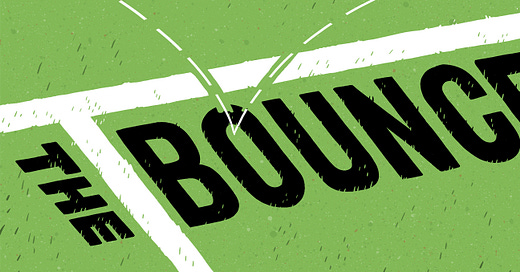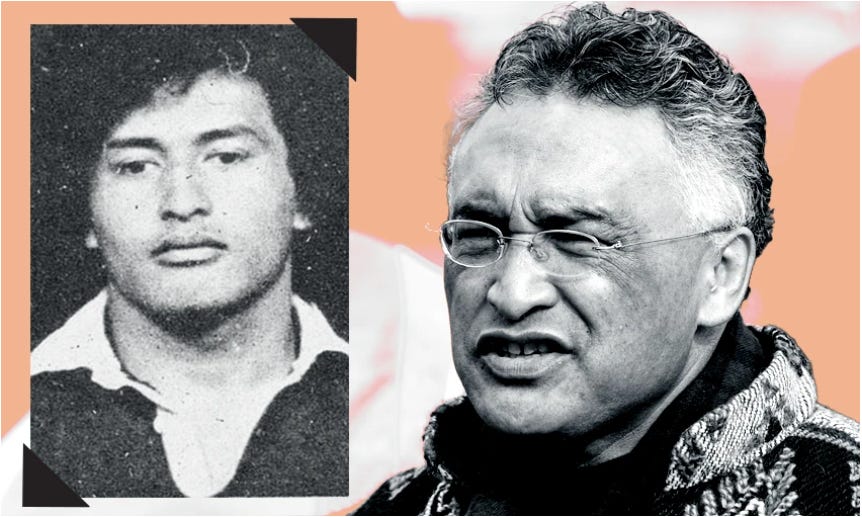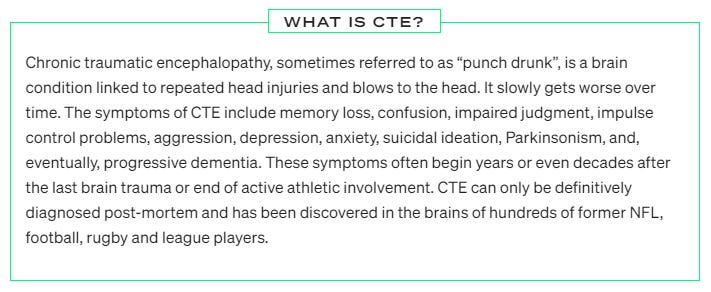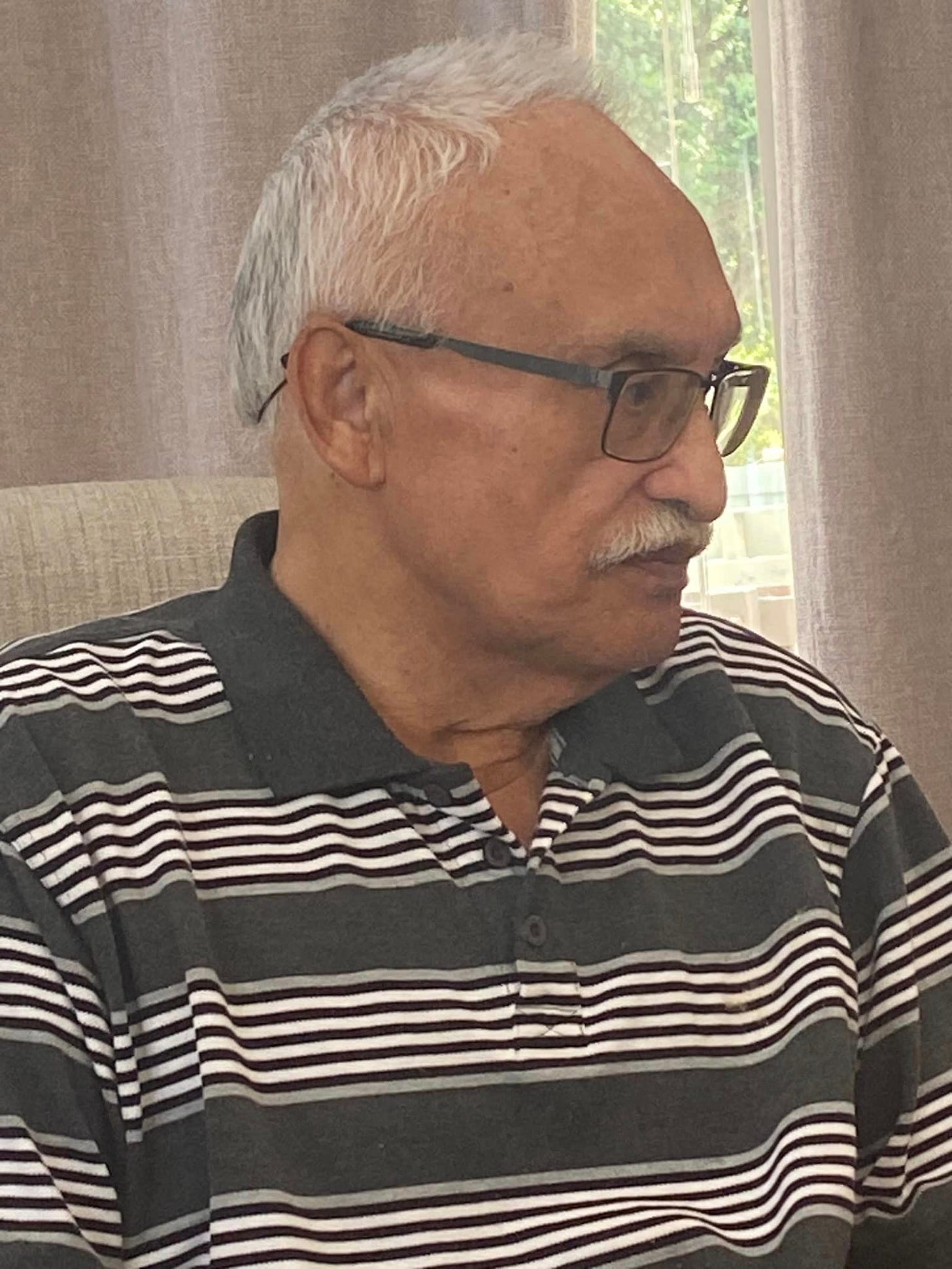Inside Tu Wyllie's long fight for recognition
A story to share while The Bounce prepares to return
Just a quick note to let you know The Bounce will return tomorrow and follow a two-per-week schedule until after the Easter school holidays, before moving back to the usual three- to four-per-week from April 24. There has been a number of new sign-ups even during this brief hiatus, so word of mouth and hitting that ‘Share The Bounce’ button is working. Please keep it up… it’s appreciated.
Thanks for your patience and in the meantime, I’ll share with you a piece I wrote for The Spinoff last week (March 23), detailing former All Black Tutekawa ‘Tu’ Wyllie’s battle to have his diagnosis of probable CTE recognised by the ACC. I first met Margaret Wyllie, Tu’s wife of more than 40 years, in Auckland in 2020 as she was preparing her husband, who was already in an advanced state of cognitive decline, for a consultation with noted neurologist Rosamund Hill. We’ve kept in touch since and in February this year I visited them again at their Wellington flat. Margaret was ready to tell Tu’s story.
She is a remarkable woman. This is just as much her story.
Wellington rugby stalwart, one-game All Black and former New Zealand First MP Tutekawa Wyllie has had his probable chronic traumatic encephalopathy (CTE) condition recognised and compensated for by ACC after a five-year campaign.
The ACC said there have been “less than four” such cases in New Zealand – the corporation will not give out exact data when the numbers are low for fear of inadvertently identifying clients.
While it is understood that another ex-All Black may have been diagnosed and covered by the ACC, the Wyllies are the first to go public.
In the course of this reporting, it has been discovered that there are at least two ex-All Blacks whose families believe they have CTE, who have either been declined by ACC or have given up seeking cover out of frustration with the process.
Carl Hayman, the outstanding former tighthead prop who went public with his diagnosis of early-onset dementia and probable CTE in 2021, has spoken about his frustration at the lack of support from the New Zealand health system.
“I went to the doctors here before I went to the UK but the process seemed like it was going to take a long time and I was getting to the point where I needed answers,” he said at the time.
Tu Wyllie is an unlikely groundbreaker. The intelligent, fiercely independent man who was fluent in Te Reo and English, is no longer verbal, cannot move unaided and has lost all independence.
Wyllie is now funded for care administered by his wife Margaret. Their houses have been modified to cater for his accessibility needs, as has their car. This reporter can testify, having met Tutekawa three years ago and again recently, his deterioration has been significant.
He is just 68, and Margaret says she finds his plight particularly hard to accept when she runs into colleagues and rugby contemporaries of Tu who were still fully active and working.
Wyllie’s hard-fought victory is the result of his wife’s single-minded refusal to accept denials, and a lawyer who believed the ACC, the Crown-administered no-fault scheme, had lost sight of its quintessential premise to care for injured New Zealanders.
“Tu’s been a worker all his life and I’m not talking about nine to five,” says Margaret Wyllie at a flat they maintain in the Wellington suburb of Miramar, where they have been forced into an extended stay after Cyclone Gabrielle made it impossible to return to their home just south of Gisborne. “He was in good jobs and earned good salaries, but financially it feels like we’ve just left varsity.
“The battle to get his disease recognised by ACC was not even about the money. Yes, it has given us a measure of comfort for the future, but it’s just such a relief for me and his wider family to have his condition recognised and to know that he hadn’t just gone randomly doolally.”
Margaret, who has been married to Wyllie for more than 40 years, is telling her story now because she fears that many more in her husband’s position have neither the wherewithal, the support or the patience to keep climbing over the kind of brick walls that were put in front of them.
Their account is poignant. It details the vivid diminution of a high-achieving person. The sad fact is that it is not unique. Many stories have already been told of rugby stars who believe the sport they loved contributed to their dementia, and there will be many more to come.
What elevates their story is that they fought the system and won. It’s a significant victory, though in some ways a hollow one: Wyllie will eventually die with no idea as to the significance of his case, or how many people might benefit from his trailblazing.
***
Tutekawa Wyllie, almost always shortened to “Tu” during his playing days, was a strong-willed first five-eighth who played much “bigger” than his 1.63m and 69kg frame should have allowed. Veteran rugby commentator and Wellingtonian Grant Nisbett says Wyllie was a key component in a golden age of Wellington rugby where the backline sparkled with the talents of the likes of Stu Wilson, Jamie Salmon, Allan Hewson and Bernie Fraser.
“They were all runners and that started with Tu at first-five,” Nisbett says. “He was a running first-five far more than he was a kicking one. He ran very low to the ground and scored a lot of tries because he was hard to tackle.
“He was fearless, too. He wasn’t afraid of putting his head into places where most other backs wouldn’t go.”
Wyllie played one match for the All Blacks, a game against Fiji at Eden Park that, like most matches against “minnow” nations in those days, wasn’t awarded test status. While he marked the occasion with a try, it was his only appearance for the national side, something that irked many of his fans in the capital who, in a period of volatility at the position, saw others like Doug Rollerson, John Boe, Nicky Allen, Wayne Smith and Brian McKechnie handed opportunities ahead of him.
Wyllie had come to Wellington via Gisborne. He went to Victoria to study for a Bachelor of Arts and work towards a law degree, and found himself playing league for NZ Universities while continuing his rugby career.
He played for Wellington until 1983 and would later coach the Marist St Pats club for which he had played more than 100 games. Wyllie represented the Māori All Blacks from 1979 to 1982, with the ’82 tour to Europe – which included “tests” against a Wales XV at Cardiff Arms Park and Spain – a highlight.
Post-rugby, Wyllie had a varied career that involved law clerking and Treaty settlement negotiations. He was an advocate for Ngāi Tāmanuhiri, Ngāti Ruapani and Rongowhakaata iwi he was affiliated to.
His highest profile role was as the first member of parliament for the Te Tai Tonga electorate, defeating Labour Party veteran Whetu Tirikatene-Sullivan by just 285 votes to win the seat for New Zealand First in 1996.
Margaret says his politics were hard to define other than “definitely not right [wing]”, and that in some ways he was an accidental politician, having been contacted by Winston Peters and agreeing to put his name forward without any real expectation of beating Tirikatene-Sullivan, part of the Labour Party lineage.
Wyllie became part of NZF’s self-styled Tight Five, along with Tau Henare, Rana Waitai, Tukoroirangi Morgan and Tuariki Delamere.
His career had moved from the physical to the intellectual, but like a rugby player in the spotlight, he wasn’t without his critics.
It was a volatile period in Māori politics and when Henare split to form Mauri Pacific, he took Waitai and Morgan with him. Delamere opted initially to become an independent and only Wyllie chose to remain loyal to NZ First, where he remained until defeated soundly by Labour at the 1999 election.
One of the charges laid against him, most notably by former Tight Five colleague Delamere, was that Wyllie’s advocacy for his people only happened when he was out of the House.
Margaret says her husband started showing signs of decline in 2010, when he hit his mid-50s. They were subtle changes at first, such as silly, often indiscriminate arguments over trivial matters. She recalled him being banned from McDonald’s in Taradale for lashing out at staff when his fries weren’t hot enough.
Irrationality and impulse control are early signs of cognitive dysfunction but they could also be put down to “grumpy old man” syndrome.
By 2013, however, there were enough signs that Wyllie’s irritability was not a phase; not a sign of general displeasure with life, but a symptom of an underlying and much more troubling problem. Wyllie was becoming easily confused. Words that once rolled off the tongue started to trip. He was one of the main speakers at the Manutuke marae “but started making glaring mistakes”, according to his wife.
Wyllie would become obsessive about single tasks, even seemingly unimportant ones, at the cost of all others.
This driven individual who was known as a people-person began to isolate himself and “started doing unrecognisable and quirky” things. The couple lived by the sea at Poverty Bay, but “suddenly Tu wouldn’t get in the water under any circumstances,” Margaret says.
The incident that hammered home the fact that their lives were changing irrevocably was when Wyllie, having been on a holiday to Perth to see family, had a “full-blown panic attack” at the airport before returning home.
Margaret knew it went deeper than panic. She also saw deep confusion and a childlike fear.
It was a sign of big trouble.
***
We’ve rewound the clock to 2010 here, but really, if you want to go to what Margaret believes is the root cause of the issue, we have to wind back a lot further to May, 1982. It was then that Wyllie, playing for Wellington and the famous Marist St Pats club, suffered a number of concussions in a short space of time, necessitating a visit to a neurology department at Wellington hospital.
A letter signed by a registrar on behalf of late neurologist Dr Jack Bergin states in detail Wyllie’s rugby injuries. It would be a vital piece of evidence that the Wyllies would later use in their claim with ACC (the excerpt here is lightly edited for clarity).
“[Tu] was quite well until three weeks ago when, while playing rugby, [he] was tackled in mid trunk unexpectedly. His head and upper half of his body swung forwards and backwards in a sudden movement. There was no loss of consciousness but an immediate feeling of dizziness [as] if stunned. He continued playing and about three minutes later suddenly felt dizzy and fell. He describes his head spinning and the ground moving. He had to close his eyes and had no sense of balance.
“He continued to play. He says he felt out of it and stoned [and for] the next 20 minutes had trouble running in a straight line to where the ball was. He felt that his reflexes such as catching the ball and making decisions were impaired. Shortly before the end of the match he felt that he was back to normal. That evening he drank some beer, but not excessively. The following morning he woke feeling dizzy and with a headache. The headache was described as like a buzz. It was not throbbing. It was sited in the occipital and right temporal region. There was an excessive feeling of tiredness and wanting to sleep. He noted difficulty with perception, for example judging how far a book was away. There was trouble with his balance and a feeling as if he was about to fall.
“A week later (5.5.82), Tu played in another match – Wellington versus New Zealand Universities – and took it easy.
“The following Saturday (8.5.82) he played in a club match and was run over by a large forward and was hit on the head by a knee. Again, he felt dizzy and fuzzy and did not know where he was. He did not go off the field, but noted that he had difficulty catching the ball, difficulty reacting normally, and difficulty calling instructions. He was also tackled more than he usually would have been. The following day he felt light-headed and if he turned too quickly was likely to bump into something.
“Tu played in a further match on 15.5.82. He was confronted head-on by a large Samoan forward whom he tackled, but sustained a knee in the head in the process. He felt dizzy again for 10 to 15 minutes. In the early hours of the morning of 17.5.82, [Tu] awoke with a splitting headache. It was sited in the right temporal region and was throbbing… It woke him from sleep… Headache was still present but to a lesser extent when seen by Bergin on Tuesday. 18.5.82.
“Once again he thought he was satisfactory on Wednesday, 19.5.82, when played in a representative match (Wellington versus Wanganui). He did not have his usual game and on one occasion walked into a goalpost and hit his head. This was amusing to the crowd.”
It is a frightening litany of head injuries followed by an even more frightening lack of recovery time between games.
The letter lists some of the symptoms he continued to feel, including feeling “stupid”, blurred vision, an inability to drive his car and a feeling of imminent unconsciousness. Wyllie, it says, had the sensation of falling to his right, experienced the room spinning and endured excessive feelings of tiredness.
His medical history recorded no major incidents, though he had been taking the since-discontinued medicine phenylbutazone on and off for a decade to combat joint pain.
It was noted that he was a non-smoker and that alcohol was confined to Saturday and not to excess. He was described, in language of the times, as “a well built, intelligent, young Māori man”, and it was laid out that the “findings would be consistent with a post-concussional syndrome”.
Wyllie would lodge a successful claim with the ACC in 1982, which his lawyer Brittany Peck would later argue should have covered him for all the mental and physical consequences of that injury.
That would come later.
Bergin’s notes in 1982, however, conclude with the metaphoric sound of a gate being shut once the horse has bolted.
“Instructed to rest and certainly not to play any more rugby in the meantime.”
There is both an extremely complicated and very simple way of telling the story of the journey of Tu and Margaret Wyllie since they started seeking medical and financial support in 2017 for his sharp decline.
The short story is that after going into the ACC’s medical diagnosis wringer – which at one point had them being consulted for a neurological condition by a wart specialist – the Wyllies were twice denied support.
After a self-funded positron emission tomography (PET) scan revealed that it was unlikely he was suffering from Alzheimer’s disease, ACC accepted that CTE was the likely cause of neurodegeneration and funding was granted.
The full version is too circuitous and tortuous to cover even in a feature-length article, but the bullet-pointed outline is this:
In 2017, with Wyllie’s cognitive decline rapid and obvious, an MRI reported “moderate deep white matter small vessel disease”. His GP would diagnose multi-infarct dementia and “likely” CTE, referring him to the Wellington neurology department.
A year later, in April 2018, a Wellington neurologist noted that it was “entirely possible that repeated head trauma, vascular dementia and/or incoming neurodegeneration play a contributing role” in Wyllie’s condition.
Three months later a consultant psychiatrist stated that “it may be that cognitive impairment, driven by multiple head injuries in the context of life-long rugby practice (chronic traumatic encephalopathy, or CTE) has triggered depression in this man who has held high mana within his family and community.”
A further MRI in October 2018 reported “age appropriate cerebral and mid brain… changes, however, no clear evidence of traumatic brain injury.”
In February, 2019, a clinical psychologist filed a Neuropsychological Assessment report for the Wyllies, writing (abridged, emphasis added): “CTE is posited to be characterised by three key groupings of symptoms… Tutekawa’s presentation fulfils each of these key groupings. It is quite possible that the neurodegeneration evidenced in his repeated head scans has arisen from a separate organic process unrelated to his previous head injuries, but the early onset of his condition, and the lack of family history of these types of symptoms gives weight to the hypothesis that he is experiencing the effects of CTE.
In April of the same year, Dr Sally Rimkkeit completed a certificate asking for the CTE diagnosis to be added to Wyllie’s covered injury of 1982.
In January 2020, Dr Andrew Chancellor, a consultant neurologist provided a report to ACC and while noting issues with a vascular dementia diagnosis, said it was the best fit for Wyllie and noted: “I am unable to make a diagnosis of CTE – and consider this not the case.”
Having already declined an extension to Wyllie’s cover due to having insufficient information, on receiving Chancellor’s report, in February 2020 ACC issued a further decline decision.
At this point, Margaret Wyllie fears, most people would give up, but with the help of the Rugby Foundation she found her way to lawyer Brittany Peck, who wasn’t much interested in taking no for an answer.
What follows is by necessity an incomplete picture, but the Wyllies sought further opinion, including from noted neurologist Dr Rosamund Hill. The results of a lumbar puncture were tested in Melbourne and Hill noted they were “NOT strongly supportive of Alzheimer’s disease.”
She concluded: “The exact diagnosis of his dementia has not been clarified but the most likely diagnosis, in my opinion, with the current information available is Traumatic Encephalopathy Syndrome.”
ACC, however, did not accept Hill’s report and referred it to their consultant Chancellor for comment. In June, 2021, he noted that CTE was a possibility, but that he remained unconvinced as Wyllie did not display “neurobehavioral dysregulation such as explosiveness, impulsivity, rage, violent outbursts, and emotional lability, that are incorporated as one ‘modus operandi’ into research criteria for (CTE).”
Dr Chancellor did note that a PET scan may provide, if it returned negative for amyloid, therefore making a diagnosis of Alzheimer’s extremely unlikely, “more grounds for accepting cover for CTE (ie injury) as the cause of Tu’s cognitive decline.”
The Wyllies found the $5000 to make the trip to Christchurch and pay for the PET scan, which subsequently returned a negative for amyloid, a protein that would have pointed towards Alzheimer’s, a form of dementia related to ageing, rather than CTE, which is caused by injury.
A subsequent report by Chancellor said: “I now accept that Mr Wyllie’s condition is not explained by alternative causes of dementia and that his condition is appropriately attributed to TES with ‘probable’ CTE, caused by his rugby career. I recommend ACC accept this claim.”
“They finally caved,” Margaret Wyllie says of ACC.
The ACC’s version, provided by a statement from Dr John Robson, chief clinical officer and head of health partnerships, is this:
“In 1982 ACC accepted a claim for Tu Wyllie for a traumatic brain injury caused by rugby. In 2019, we received further medical information for an additional diagnosis of probable chronic traumatic encephalopathy (CTE). We accepted this additional diagnosis as ‘traumatic encephalopathy syndrome with probable CTE’ in March 2022.
“Tu gets funding for 24-7 care, housing modifications, modified motor vehicle, power wheelchair, medical supplies and equipment.”
Margaret is grateful for the funding, saying it provides a level of comfort missing previously, but she is still angry at how long and convoluted the process was to get there.
“I know they have processes but there is not enough acknowledgement that there are real people at the end of the line. It’s almost like they have a line they have to take. We could have given up so many times. I mean, one of the first people they sent us to, one of his specialties was warts – warts!”
Peck, whose John Miller Law firm markets itself as ACC specialists, says when it comes to assessing traumatic brain injuries, the Crown agency has lost sight of its remit.
“ACC has been charged with taking care of us when we’re injured,” she says. “That’s where their responsibility lies.
“It’s an important scheme because it took away significant legal rights for New Zealanders.
“It’s not just about covering your injury on the day; it’s the ongoing consequences and downstream effects of the injuries, even if they happen in the beloved national sport.
“That’s the price to pay for not being able to sue in New Zealand.”
Peck said the ACC applies “far too high a standard” to claims when assessing the issue of causation. The ACC is bound by the balance of probability but when it came to CTE, she says, the burden of proof was suddenly on the victim to prove causation.
“They are far too rigorous. As early as 2018 medical professionals were referencing Tu’s multiple concussions but it wasn’t until 2022 that they accepted cover.”
ACC’s Robson said there are unique complications when assessing the probability of CTE and that an “inappropriate” diagnosis can cause further damage.
“The clinical evidence on CTE (a neuropathological diagnosis) is rapidly developing and the causal link between a history of repetitive brain injury and CTE continues to be researched,” he said.
He said that while the diagnosis of CTE requires an examination that demonstrates deposits of tau protein and can only be done post-mortem, TES is a clinical is a clinical syndrome with current consensus on diagnostic criteria involving cognitive, behavioural and psychiatric symptoms thought to be due to exposure to repetitive brain injury.
“[However], a diagnosis of TES does not equate to a diagnosis of CTE,” Robson stated.
Responding to criticism that the ACC makes it too difficult for clients with probable CTE to have that disease recognised, Robson said: “Inappropriate diagnosis of CTE can be harmful, leading to additional mental health difficulties, as well as a reduction in the diagnostic evaluation and intervention for treatable conditions. We use the best information available at the time to make a cover decision. In order to determine the diagnosis ACC looks at each claim on a case-by-case [basis] and will exhaust all treatable diagnoses.”
In Chancellor’s final report in which he supports the Wyllies’ claim, he also said: “ACC can expect to receive more such claims as our ability to differentiate TES/CTE from other neuro-cognitive disorders improves.”
Peck says the Wyllies’ contribution to this particular branch of medical history could be huge.
“Margaret Wyllie is a very strong woman. She’s had to be,” Peck says. “It was not at all surprising to me that they were going to do the same thing they had done all their lives and that was to fight for something they believed in.”
The Wyllies might look back on this saga with pride, but for the moment it’s a different kind of emotion.
“It’s just such a relief when people believe you,” Margaret says.








Many thanks to Dylan for taking the time to document our story. His effort over many years to bring attention to the realities of CTE is making a difference. Nga mihi - Margaret and Tutekawa Wyllie
Thank you for this piece of work Dylan - I think it will go down as one of the most important pieces of sports journalism (no need for the sports in all truthfulness) to have been written in a very long time.